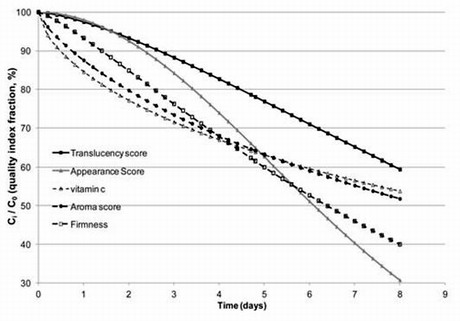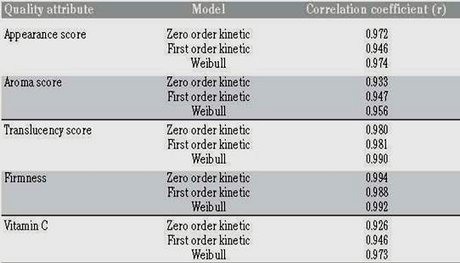Within the European Project Quafety on quality and safety of fresh-cut produce (2011-2014), the scientists of the University of Foggia (Italy) have investigated the degradation kinetics of the main quality attributes to better define the shelf-life of fresh-cut melon.
For the study, the melon cubes were stored in air at 5°C for 8 days, during which color, external appearance, aroma, translucency, firmness, content of soluble solids, fructose, vitamin C, phenols and antioxidant activity were measured. In addition, the overall appearance of the fresh-cut melon was evaluated by a panel of experts through a 1-5 scale (where 1= inedible, very poor with strong defects; 3 = fair with acceptable defects; 5 = typical attribute, very intense, without defects).
Time evolution of some sensorial and chemical changes of fresh-cut melon samples during storage at 5°C.

The quality attributes showing significant changes during storage were used to test both kinetic models of zero and first order and Weibull models.
The Weibull model resulted the most accurate in describing changes in external appearance, translucency, aroma, firmness, and vitamina C, while no models resulted accurate in predicting the changes over time of all the other parameters.
According to the Weibull model, the limits of marketability and edibility of fresh-cut melon based on appearance score were 5 and 7 days of storage, respectively. Furthermore, the use of this logistical model allowed to determine with accuracy non-marketable and non-edible packages as a function of the average appearance score.
Goodness of fitting of zero and first kinetics and Weibull models used to estimate some quality attributes of fresh-cut melon samples.

In this way, it was possible to confirm that when the average appearance score reached the limit of the marketability, the 36% of packages were already below this limit.
The authors concluded that this information should be used to optimize the logistical chain by increasing the quality of fresh-cut melons on the market and reducing the related costs.
Source: Amodio M.L., Derossi A., Colelli G., "Modelling sensorial and nutritional changes to better define quality and shelf-life of fresh-cut melons", 2013, Journal of Agricultural Engineering, Volume XLIV:38-44. Further info: http://www.agroengineering.org/jae/article/view/jae.2013.e6








